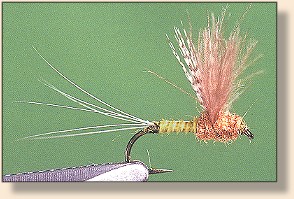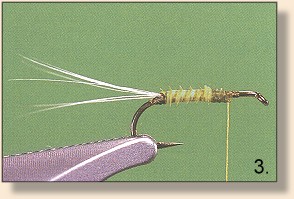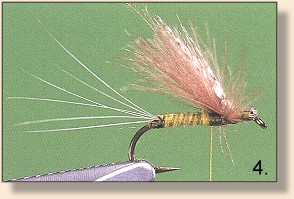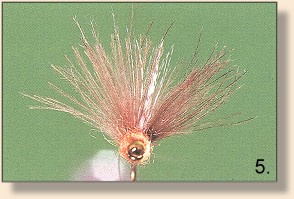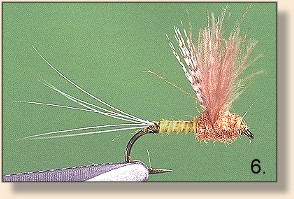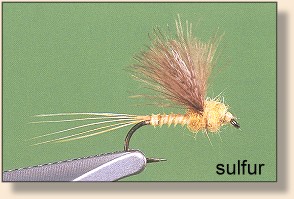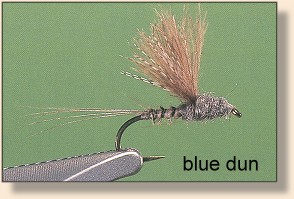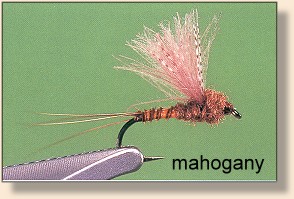Blue-Wing Olive
CDC Biot Comparadun
By Dave Hughes
Matching Duns
It's not possible, at least for me, to understand why trout
will be happy to accept one fly, then suddenly and arbitrarily
begin refusing it and demand another. It can depend on the
weather, the luck or lack of it that the insects might be
having getting through the barrier of the surface film that
day, or the preference of one trout for emergers over duns,
another for crippled duns over fully formed duns, and a final
fish that is a snob toward anything but a perfect dun. Whatever
the reasons, you'll never solve all of these trout with any
one-fly theory.
The truth is, you'll never solve all trout with any theory.
But you'll solve a lot more trout with a few options in your
fly boxes than you ever will with just one.
If you tie a series of fly styles to imitate mayflies, each
of which floats in a different way, and therefore shows a
different shape and silhouette to trout, you'll nearly always
be armed with a dressing they will accept. You just need to
have a style in your fly boxes in the right size and approximate
color...
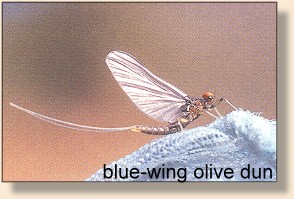
Blue-winged olives extend from tiny size 20 Baetis
up through the lesser green drakes in size 12 and 14 to the largest
size 8 and 10 green drakes themselves. Sulfurs, both eastern and
western species of Ephemerella, begin at sizr 16 and
18, but can be enlarged to encompass the giant and widespread size
6 and 8 Hexs (Hexagenia). Blue duns, beginning with
the tongue-twisting size 14 and 16 Paraleptophlebia, can
be extended to include the size 10 and 12 gray drakes
(Siphlonurus). Mahoganies and March browns, in
the genera Paraleptobhlebia, Stenonema, and
Rhithrogena, generally run the narrow range from size 12
to 16.
If you tie and carry flies to cover these themes, each in an
appropriate range of sizes, you'll have most mayfly dun hatches
covered. Extend the size range only when you encounter a specific
hatch that demands it, on your own waters, in your own fishing.
The goal is to wind up with a fly box or two that covers the basic
mayfly hatches across the continent, and even worldwide.
Since the way they float gives them some of the aspects of emergers,
we'll begin our continuum of dun imitations at the end of flotation
on the smoothest water, with CDC Biot Comparaduns. This fly style
was originated by the great young Colorado tier, Shane Stalcup.
Materials: Blue-Wing Olive
CDC Biot Comparadun
- Hook: Standard dry fly, 1x fine, size 12 to 20
- Thread: Olive 6/0 or 8/0.
- Tail: Blue dun hackle fibers, split.
- Abdomen: Olive turkey or goose biot - The
biot is the short, sharp fiber on the leading edge of a
wing primary feather. Buy feathers dyed to the primary
colors you'll use to cover the color themes: olive, pale
yellow, gray, and brown. Before beginning to tie, peel
the number you need from the feather and place them
between moist paper towels to soften..
Tying Steps:
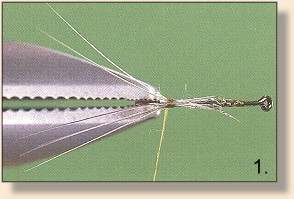
1. Fix hook in vise and layer shank with thread. Form a slight thread hump at
the bend with several turns of thread taken over each other. Select six to ten
stiff and web-free hackle fibers, measure than the length of the entire hook, and
tie them in at the bend. Use your fingers to split the hackle equally to each side,
while taking thread wraps back against the hump to lock them in place.
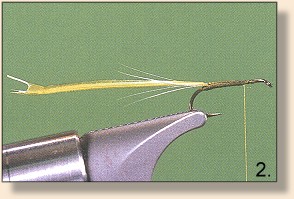
2. Take one thread layer forward two-thirds of the shank length over the
tail butts before trimming the excess. Take another ever layer of thread
back to the tail base. It's important to form an even underbody for a
biot body. Select a biot and tie it in by the tip, with the convex side
toward the hook.
|

